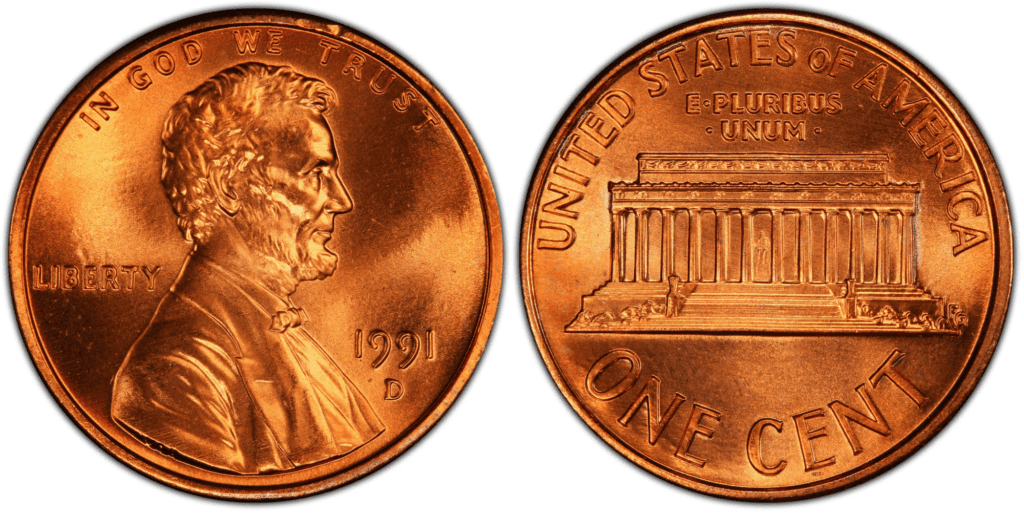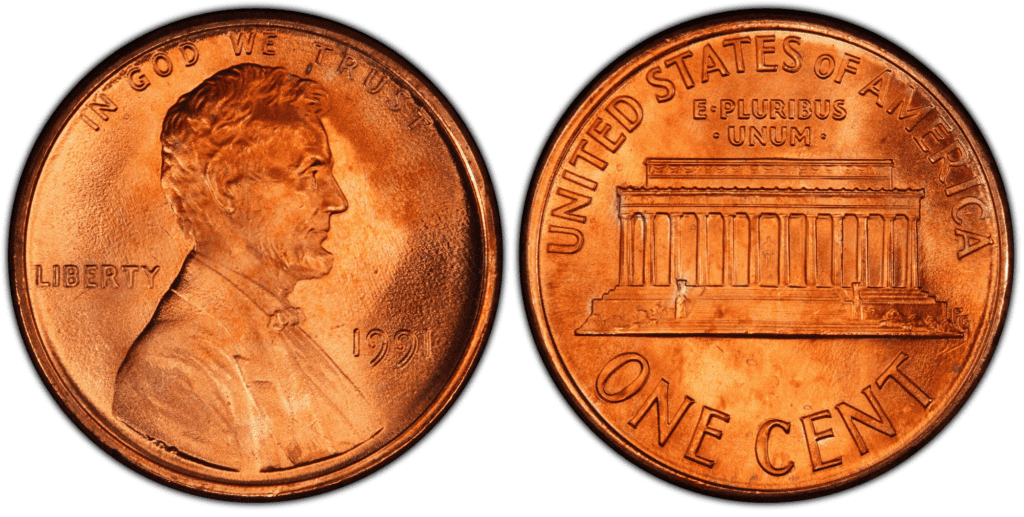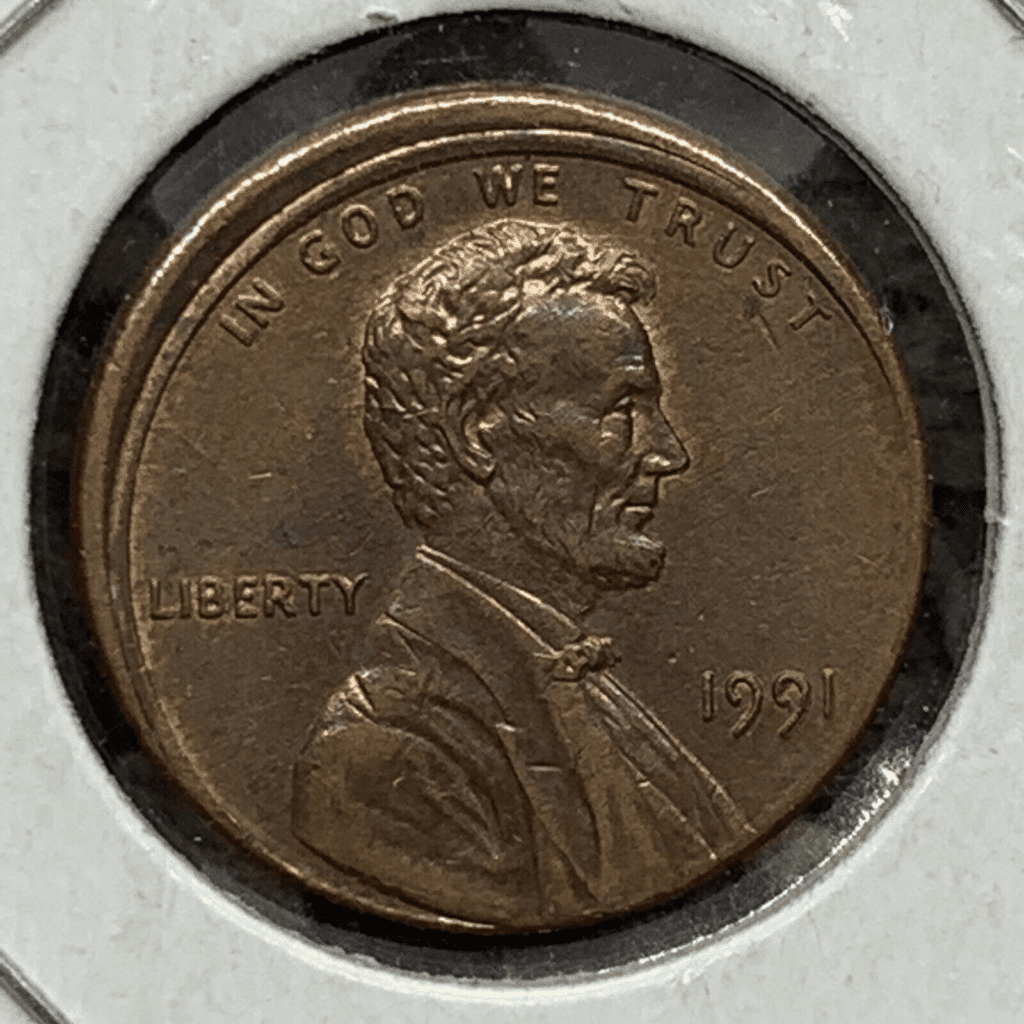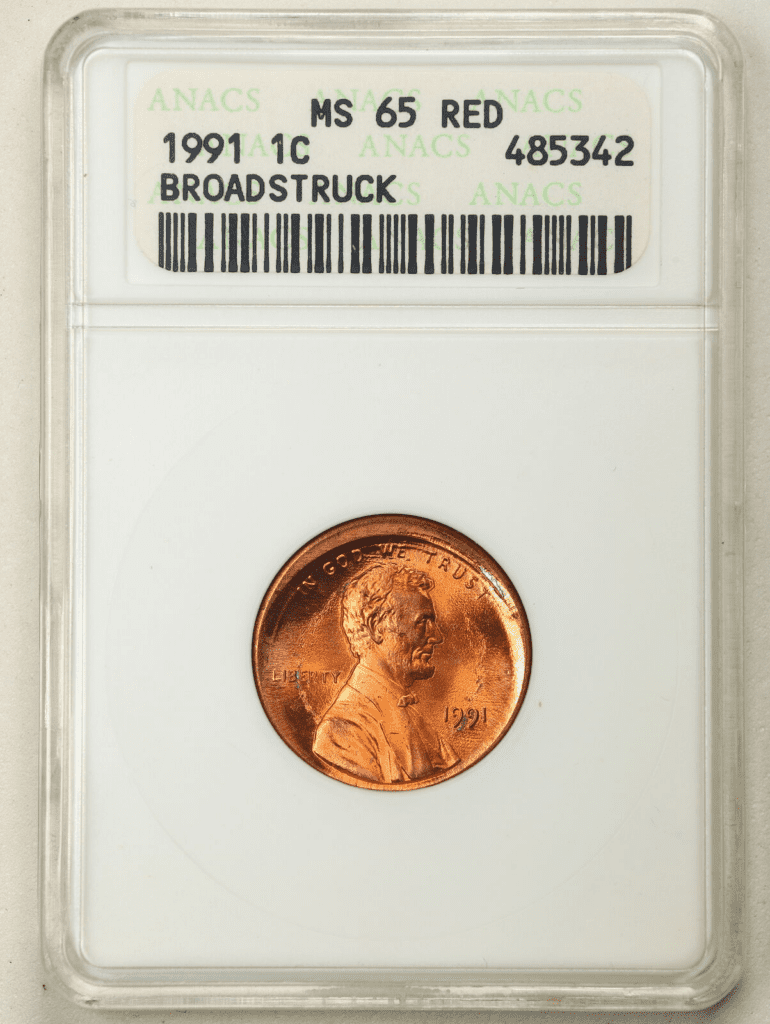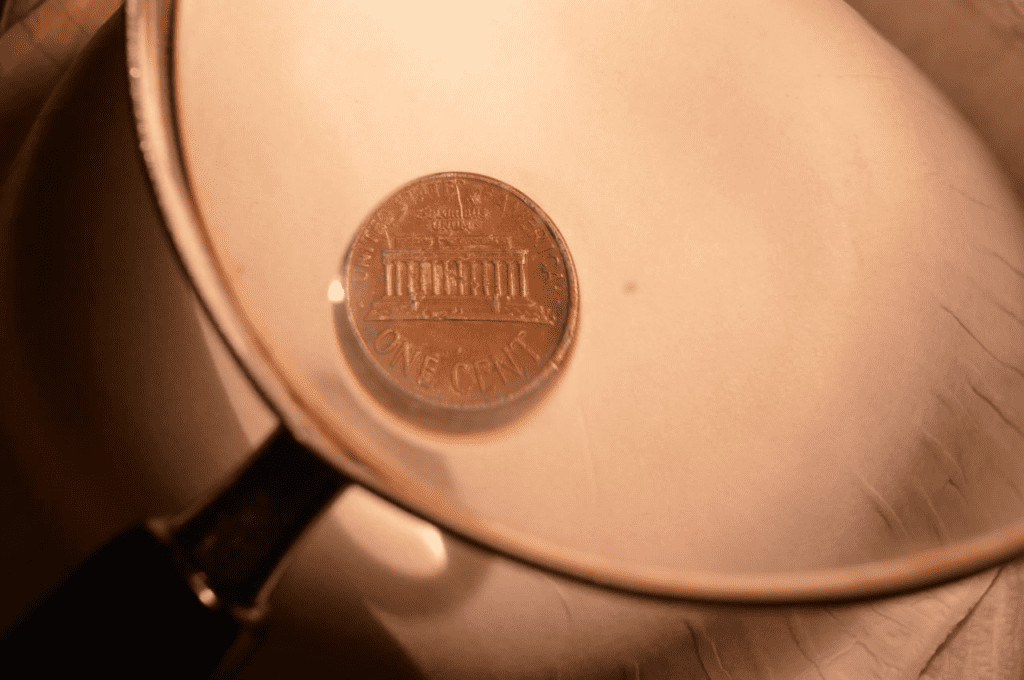What Is the 1991 Lincoln Penny Made Of?
The 1991 Lincoln penny is made of 97.5% zinc and 2.5% copper. It has a solid zinc core while it is plated with copper.
The Lincoln penny isn’t always this way. Here’s a quick history of its composition in the past:
- 95% copper and 5% tin or zinc – 1909 to 1942, 1944 to 1982
- Zinc-plated steel – 1943
Starting in 1982, the Lincoln penny began to have its current composition — 2.5% zinc and 97.5% copper.
Here are some other of its specifications:
- Face value: 1 cent
- Diameter: 19.05
- Mass: 2.5 g
- Edge: Plain
- Years of minting: from 1909 to present
The obverse was designed by Victor David Brenner while the reverse was designed by Frank Gasparro.

photo source: USA Coin Book
The obverse includes the right profile of Abraham Lincoln, the 16th president of the United States. He was chosen to be the new face of the penny in 1909, which is also the centennial year of his birth.
On the obverse, you’ll find the following inscriptions:
- IN GOD WE TRUST
- LIBERTY
- 1991
On the reverse, you’ll find the front view of the Lincoln Memorial. The inscriptions include the following:
- UNITED STATES OF AMERICA
- E PLURIBUS UNUM
- ONE CENT
Officially, the one-cent coin is called the Lincoln cent. However, it’s also called the Lincoln penny. The nickname “penny” originated from England, which is the term used to refer to the coins that went to decimals in 1971.
Originally, the Lincoln design was delegated to Augustus Saint-Gaudens. However, he died before submitting his Lincoln design. As a result, the United States (US) Mint chose Victor Brenner to create the design.
The Lincoln penny is the first widely circulated US coin, which has the face of a US president. In the past, people thought of having presidents in a coin as too monarchical. However, this changed with the release of the Lincoln penny.
1991 Lincoln Penny Varieties
There are different 1991 Lincoln pennies and most of them differ based on their mint mark and where they were struck. Aside from that, there are also those pennies with errors that make them somehow unique and become a different variety.
Here are some of the most commonly known Lincoln penny varieties of 1991 you should be familiar with:
1991 D Lincoln Penny
Year of minting: 1991
Mint Mark: D
Place of minting: Philadelphia
Quantity produced: 4,158,442,076
Face Value: $0.01 (one cent)
Price: $0.01 to $0.33 (or more)
Mass: 2.5 grams
Edge: Plain
Designer: Victor D. Brenner (obverse) / Frank Gasparro (reverse)
Composition: 97.5% zinc and 2.5% copper
Diameter: 19.05 mm
Thickness: 1.52 mm

photo source: PCGS
The Denver Mint produced more than 4 billion 1991-D pennies. If you want to buy one of these or you have a penny to sell, you can expect that the value of the coin is around $0.01 to $0.33.
1991 P Lincoln Penny
Year of minting: 1991
Mint Mark: No mint mark
Place of minting: Philadelphia
Quantity produced: 5,165,940,000
Face Value: $0.01 (one cent)
Price: $0.01 to $0.33 (or more)
Mass: 2.5 grams
Edge: Plain
Designer: Victor D. Brenner (obverse) / Frank Gasparro (reverse)
Composition: 97.5% zinc and 2.5% copper
Diameter: 19.05 mm
Thickness: 1.52 mm

photo source: PCGS
The no-mint mark 1991 penny was made in the Philadelphia Mint. The Mint produced more than 5.1 billion pennies and you can sell one of these for about $0.01 to $0.33.
1991 S Lincoln Penny
Year of minting: 1991
Mint Mark: S
Place of minting: San Francisco
Quantity produced: 2,867,787
Face Value: $0.01 (one cent)
Price: $0.01 to $1.00 (or more)
Mass: 2.5 grams
Edge: Plain
Designer: Victor D. Brenner (obverse) / Frank Gasparro (reverse)
Composition: 97.5% zinc and 2.5% copper
Diameter: 19.05 mm
Thickness: 1.52 mm

photo source: PCGS
The San Francisco Mint specializes in producing proof coins. These are special coins with better eye appeal and deeper details. As a result, the whole minting process is more time-consuming and meticulous. This is the reason that the San Francisco Mint was only able to create more than 2.8 million 1991-S Lincoln penny, which is far fewer than what other Mints produced.
List Of 1991 Lincoln Penny Errors
There are billions of 1991 Lincoln pennies and thus, it is not surprising to note that there are some coins that have received errors during the minting process.
Errors may happen due to the wear and tear of minting equipment. Human error can also be a cause of coinage error. Some of the common errors include the following:
- Off-Center Error
- Die Crack Mint Error
- Mint Error
- Slight Off Rotation
To give you an idea, here are some of the 1991 Lincoln penny errors you might want to know:
Off-center error

photo source: eBay
In this error, you’ll see that the engraved elements are leaning towards the 4 o’clock direction of the coin. This happens when the die didn’t hit the Lincoln precisely at its center.
Lincoln cent with apostrophe

photo source: eBay
In this coin error, you’ll find an extra small line on the upper right side of the “1991.” it makes the year of minting look like it has an apostrophe. This could have been caused by a strike-through error.
Clipped planchet mint error

photo source: eBay
Clipped planchet mint error happens before the actual strike. Coins start out to be just a sheet of metal. They go through a blank-making machine to produce blank planchets. If the sheet is misfed to the machine, a clipped planchet error can occur.
Broadstrike error

photo source: eBay
Sometimes, there are mechanical glitches that cause the retaining collar not to engage with the planchet. When the die strikes the coin, it doesn’t stay in its place. Thus, you’ll see the broad strike coin look flatter and wider.
Die crack with missing letters

photo source: eBay
Dies hit the planchets multiple times. Because of wear and tear, errors can happen. In this coin, the die cracks and its crack was also engraved on the coin. Plus, if you look closely, the letter “O” and “S” are missing in the words “State of.”
How Much Is the 1991 Lincoln Penny Worth Today?
The face value of 1991 is one cent. Thus, its value is just the same as its face value. The melt value is $0.0076. There’s no significant difference between the face value and melt value.
However, if you have a rare coin or a 1991 Lincoln penny in exceptionally good condition, then you might be able to sell it for a higher cost. Even if this coin is just one cent in value, there are Lincoln pennies that have been sold for thousands of dollars!
To give you an idea, here’s a table for you to compare 1991 Lincoln pennies:
| Coin | Condition | Grade | Mintage | Value |
| 1991 D Lincoln penny | Circulated/mint | Not graded | 4,158,442,076 | $0.01 to $0.33 |
| 1991 D Lincoln penny | Uncirculated/mint | MS-67 | 4,158,442,076
|
$9-$15 |
| 1991 D Lincoln penny | Uncirculated/mint | MS-68 | 4,158,442,076 | $24-$74 |
| 1991 D Lincoln penny | Uncirculated/mint | MS-69 | 4,158,442,076 | $5,405 to $11,400 |
| 1991 P Washington Quarter | Circulated/mint | Not graded | 384,764,000 | $0.25 to $0.33
|
| 1991 P Washington Quarter | Uncirculated/mint | MS-66 | 5,165,940,000 | $11 to $22 |
| 1991 P Washington Quarter | Uncirculated/mint | MS-67 | 5,165,940,000 | $192 to $259 |
| 1991 P Washington Quarter | Uncirculated/mint | MS-68 | 5,165,940,000 | $500 to $1,116 |
| 1990 S Washington Quarter | Circulated/proof | Not graded | 2,867,787 | $0.01 to $1.00 |
| 1990 S Washington Quarter | Uncirculated/proof | PR-68 | 2,867,787 | $10 to $14 |
| 1990 S Washington Quarter | Uncirculated/proof | PR-69 | 2,867,787 | $9 to $15 |
| 1990 S Washington Quarter | Uncirculated/proof | PR-70 | 2,867,787 | $44 to $155 |
As you can see, there are pennies that are really worth a lot of money. For example, a 1991-D Lincoln penny, with a grade of MS-69, was sold for $11,400 in an auction held by the Heritage Auctions in February, 2022.
Are There Any Rare 1991 Lincoln Pennies?
Yes, there are rare 1991 Lincoln pennies. These pennies are usually the ones with the highest coin grade. For example, 1991 Lincoln pennies with a grade of MS-70 or PR-70 are considered rare because only a few pennies have receive the highest grade possible. This is the main reason that MS-70 Lincoln pennies can be as expensive as $10,000!
Aside from coins with high grades, the rare coins also include those with errors. Since errors are rare to happen and errors can be different from one coin to another, then these coins are extremely rare.
Take for example the 1991-D Lincoln penny with multiple mint errors. Because it’s unique and super rare, people would be willing to pay a lot of money just to have it added to their collection.
How Does The Grading System Work?
The Sheldon Scale is used by numismatists to provide a numerical value to coins. The Sheldon Scale goes from poor (P-1) to perfect mint state (P-1) (MS-70). Coins were originally evaluated using words to reflect their condition (Good, Fair, Excellent, Etc.). Unfortunately, coin collectors and dealers had different ideas about what each of these terms represent.
Professional numismatists joined together in the 1970s and established CoinGrading standards. These numismatists now assign grades at key places on the seventy-point scale, using the most regularly utilized numeric points in conjunction with the original adjective grade. The following are the most common coin grades:
-
-
- (P-1) Poor – Indistinguishable and probably damaged; if used, must have a date and mintmark; otherwise, rather battered.
- (FR-2) Fair – Nearly smooth, but without the damage that a coin graded Poor often possesses. The coin must have enough detail to be identified.
- (G-4) Fair – Inscriptions have merged into the rims in some areas, and important elements have been mostly erased.
- (VG-8) Very Good- A little weathered, but all of the primary design elements are visible, albeit faintly. There is little if any, central detail left.
- (F-12) Good – The item is very worn, yet the wear is even, and the overall design details stand out clearly. Rims are almost completely isolated from the field.
- (VF-20) Very Fine – Moderately weathered, with some finer features still visible. The motto or all letters of LIBERTY are readable. Both sides of the coin have entire rims that are separated from the field.
- (EF-40) Extremely Fine – Gently used; all gadgets are visible, and the most important ones are bold. The finer details are bold and clear, however, light wear may be seen.
- (AU-50) Uncirculated – Slight evidence of wear on the coin’s design’s high points; may have contact marks; eye appeal should be adequate.
- (AU-58) Uncirculated Choice – Slight traces of wear, no severe contact marks, almost full mint shine, and great eye appeal.
- (MS-60) Mint State Basal – Strictly uncirculated; no indication of wear on the coin’s highest points, but an unsightly coin with reduced luster, visible contact marks, hairlines, and other flaws.
- (MS-63) Mint State Acceptable – Uncirculated, but with contact scratches and nicks, little reduced shine, but otherwise appealing appearance. The strike is weak to average.
- (MS-65) Mint State Choice – Uncirculated with great mint shine, very little contact blemishes, and exceptional eye appeal. The strike is unusually severe.
- (MS-68) Mint State Premium Quality – Uncirculated with superb luster, no obvious contact marks to the naked eye, and exceptional eye appeal. The strike is quick and appealing.
- (MS-69) Almost Perfect Mint State – Uncirculated with perfect brilliance, a sharp and appealing strike, and extremely good eye appeal. A near-perfect coin with minor imperfections in the planchet, strike, and contact markings (seen only under 8x magnification).
- (MS-70) Mint State Perfect – Under 8x magnification, there are no tiny imperfections discernible; the strike is crisp, and the coin is perfectly centered on a beautiful planchet. Rarely seen on a coin, this coin is bright and whole, with original luster and exceptional eye appeal.
-
Where To Buy Or Sell 1991 Lincoln Penny?
The best place to buy or sell 1991 Lincoln pennies would be from reputable companies. These may include coin shops, antique shops, and auction houses. There’s a greater security when you buy coins in-person since you can actually see the one you’re transacting with.
Another place for you to buy and sell 1991 Lincoln penny would be online. Simply do a quick search on Google and you should quickly find websites that sell these pennies.
You can visit Amazon, eBay, and Etsy to sell and buy your one-cent coin as well. These online selling platforms are popular websites that draw a lot of visitors each day.
Be sure to have your coins graded before selling them. This way, you’ll be able to know how much you should price your coins and get the maximum return of investment.
FAQs
Is there a missing number in the 1991 penny?
Yes, there are some 1991 pennies that might be missing a number or even other elements. One reason is because during the minting process, the die didn’t completely get in contact with the planchet, leaving some areas partially hit.
Which pennies are worth keeping?
There are different pennies that are worth keeping. Some examples would be 1914-S Lincoln penny, 1944-D Lincoln penny, 1872 Indian head penny, and others. If you believe your coin comes with rare attributes, then those pennies are worth keeping.
What is the rarest 1991 Lincoln Penny D error?
Perhaps, the rarest D penny error would be the multiple mint errors. It’s a single coin but it received different errors that make it the more difficult to find.


